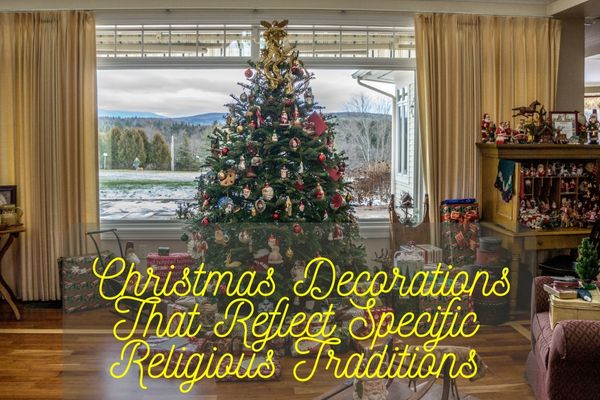Table of Contents Show
The holiday season is a time of sacred celebrations, and Christmas decorations play a significant role in expressing the unique religious traditions that shape this joyous occasion. In this guide, we’ll explore thoughtful and meaningful Christmas decorations that reflect specific religious traditions, adding a touch of spirituality to the festive atmosphere.
Christmas Decorations that Reflect Specific Religious Traditions
Christmas is filled with symbols, many of which have lost their Christian symbolism in a secular world. Here you will find the meaning of Christmas symbols.
1. Christmas Tree

Evergreen kinds such as spruce, fir, or pine are the trees that we usually adorn every December with shimmering tinsel, bright lights, and festive ornaments. These trees maintain their beautiful green foliage throughout the year. Both pagans and Christians have long utilized evergreens in their winter celebrations; Christians see the trees as symbolizing Jesus’ conception, crucifixion, and resurrection as well as their eternal life with God. This concept is further supported by Christmas trees pointing upward toward Heaven, which symbolizes our relationship with God, and by the triangular shape of trees, which represents the Holy Trinity (God, Jesus, and the Holy Spirit).
2. Mistletoe

Mistletoe is an aerial parasite that has no roots of its own. It lives off the tree to which it attaches itself and, without that tree, it would die. Mistletoe is a Christmas symbol of our love which derives from and exists only because God loves us. God, Who is Love, created us in love and caused us to be able to love.
3. Bell

A bell was a component of the Jewish high priest’s clothing. Christmas bells serve as a reminder that Christ is the High Priest in addition to representing the joy of the season.
4. Candy Cane

The shepherd’s crook-shaped candy cane serves as a reminder that Christmas is when Jesus, the Good Shepherd, entered the earth. The white background represents Christ’s purity, while the red stripe represents His sacrifice. The peppermint flavour of candy canes is similar to hyssop, which was once used medicinally. The taste of peppermint serves as a reminder that Christ’s life was sacrificed so that we could be healed. Just as Jesus’ Body is broken and distributed at every Eucharist, so too is the candy cane designed to be broken and shared.
5. Wreaths

Traditionally, evergreens like holly or pine branches are used to make wreaths. According to D&C 35:1, their circular shape can stand for eternity. A wreath placed on a door or in a window is a metaphorical call for the joy of the holiday season to permeate our homes.
6. Candles and Christmas Lights

Christmas lights and candles stand for Christ, the world’s light. Christmas lights and candles serve as a reminder to us that we are to be a light to others and lead them to Christ.
7. Star

The Christmas star, one of the festival’s more revered emblems, symbolizes the brilliant star that hung over the town of Bethlehem the night that Jesus Christ was born. The three kings, usually referred to as the wise men or magi, were led by the Star of Bethlehem to locate baby Jesus in a stable, according to the Nativity Story—sometimes known as The Christmas Story—found in the Gospel of Matthew. Additionally, the Christmas star has come to stand for harmony and hope.
8. Tinsels

Tinsels are the thin, metallic strands that are used in Christmas decorations. A legend tells of a poor, faithful family who wished to decorate a Christmas tree in honour of the Christ Child but who had no money for decorations. In the night, spiders came and spun webs across the tree. Then the Christ Child, honouring the family’s faith, turned the threads into silver.
9. Santa Claus

Saint Nicholas, the fourth Bishop of Myra, a city in modern-day Turkey, is the inspiration for Santa Claus. His feast day is December 6. Saint Nicholas was well-known for having heeded Jesus’ teaching that almsgiving, albeit usually done in secret, is a highly charitable act toward the underprivileged.
The most well-known tale is on three young ladies whose impoverished father planned to force them into prostitution to make ends meet. On three separate nights, Nicholas went to their father’s house in secret and dropped a bag of gold through an open window to stop this horrible act. The red winter coats with fur trimmings and the bishop’s mitre were appropriated for Santa’s attire, and the “jolly old man” who makes anonymous gift deliveries on Christmas Eve became the recipient of Saint Nicholas’s charity.
10. Gingerbread Men

These tasty treats are a staple on every cookie platter this time of year, as well as a popular cookie-exchange recipe. But there is a religious meaning to a gingerbread man—for many Christians, the biscuit represents God’s creation of Adam, the first man, and therefore, the rest of us.
11. The Colors Red and Green

The Christmas colours of red and green aren’t arbitrary. The crimson shade of red associated with Christmas symbolizes the blood that was shed by Jesus Christ during His crucifixion. The colour green—the hue of evergreen plants like pine trees, holly, and mistletoe that retain their leaves throughout the winter—represents Jesus Christ’s everlasting life.
12. Angels

Angels are God’s messengers. They appear several times in Scripture and continue to protect us today as each person has his or her guardian angel. The angel Gabriel announced the birth of Christ and also told St. Joseph to take Jesus and Mary to Egypt to escape Herod’s plan to kill the Christ Child. Angels appeared to the shepherds when Christ was born, singing and praising God and instructing the shepherds to hurry to Bethlehem to see the newborn King. Angels symbolize God’s presence and remind us of obedience to Him and praise of Him







